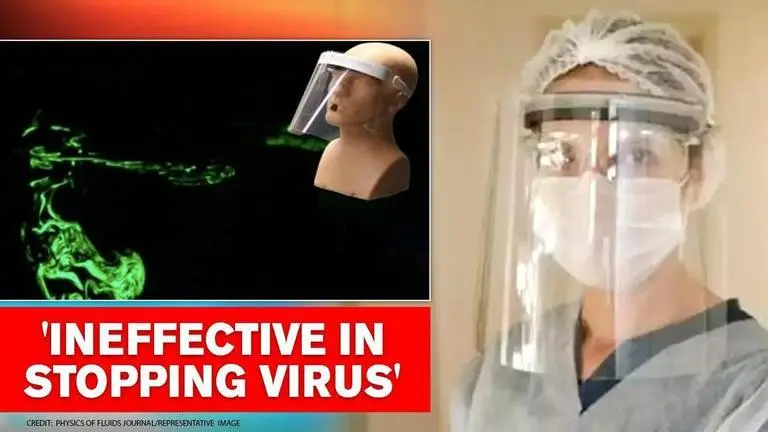Updated 2 September 2020 at 17:54 IST
Study illustrates how masks with exhalation valves and face shields allow COVID-19 spread
In the study, scientists found that the large expelled droplets could, in fact, escape from masks at a faster speed and spread across a vast area.
- World News
- 4 min read

Masks with valves, plastic face shields are ineffective in preventing the transmission of the novel coronavirus as they can still spray invisible droplets when the person coughs or sneezes, a new study published in the US journal Physics of Fluids has found. A simulation model demonstrated by the researchers at Florida Atlantic University used vertical and horizontal laser sheets and distilled water and glycerin as droplets to conduct an experiment on the mannequin head that wore similar plastic face shield or a masks with valves. In the experiment, scientists found that the large expelled droplets could, in fact, escape from masks at a faster speed and spread across a vast expanse of the enclosed area where the experiment was conducted.
“A large number of droplets pass through the exhale valve unfiltered, which make it ineffective in stopping the spread the Covid-19 virus if the person wearing the mask is infected,” researchers said in the study.
[Far-field view of a droplet spread when a face shield is used to impede the jet, 2.97 seconds after the initiation of the emulated cough. Credit: Siddhartha Verma, Manhar Dhanak, John Frankenfield/ Physics of Fluids Journal]
[Researchers also tested an N-95 rated face mask with exhalation valves and found the exhalation port significantly reduced the effectiveness of the mask as a means of source control. Credit: Florida Atlantic University's College of Engineering and Computer Science]
Scientists concluded that the thick clothed masks without openings, a well fitted medical mask or N95 mask, was much more effective in curbing the transmission of the coronavirus. The effectiveness of face shields alone was also found extremely low as it was possible that the aerosol-sized droplets could spread from the surrounding opening areas of the shields, similar to the exhalation valves of the masks.
Advertisement
Months into the COVID-19 pandemic, wearing a mask while out in public has become the recommended practice. However, many still question the effectiveness of this. https://t.co/PaZUTJErzR
— AIP Publishing (@AIP_Publishing) August 26, 2020
Advertisement
Scientists concluded that the use of shields and masks with poor quality fabrics and exhalation valves had an adverse effect on mitigation efforts to stem the novel respiratory disease and gave the sense of false security to people. Researchers proved the ineffectiveness of these defective masks worn largely by the people in a laboratory setting by calculating the forward motion of the expelled droplets. In the Visualizations videos that researchers created, they demonstrated in detail the link of the exhalation port in the masks with reduced effectiveness proving that mask was no means of source control of the disease.
“From this latest study, we were able to observe that face shields are able to block the initial forward motion of the exhaled jet,” Ph.D., department chair, professor, and director of SeaTech, who co-authored the paper, Manhar Dhanak said in the research.
“The aerosolized droplets expelled with the jet are able to move around the visor with relative ease. Over time, these droplets can disperse over a wide area in both lateral and longitudinal directions, albeit with decreasing droplet concentration,” he concluded.
Aerosols spread in reverse direction
Researchers also found in the study that the droplets could also spread in the reverse direction. In fact, once released in the environment, the aerosols spread in multilateral angles on light ambient disturbances to cover large area. “There is an increasing trend of people substituting regular cloth or surgical masks with clear plastic face shields,” Verma said. “While the driving factor is comfort, these masks have noticeable gaps that filter inhaled air but exhaled breath passes through valve unfiltered.” He cited an instance where a COVID-19 patient wore these masks that led to the spread of aerosolized droplets.
[Visualization of droplet spread when a regular N95-rated mask is used to impede the jet. (a) Prior to emulating a cough/sneeze, (b) 0.13 s after the initiation of the emulated cough, (c) after 0.33 s, and (d) after 0.83 s. Credit: https://aip.scitation.org/]
[Visualization of the droplet spread when a surgical mask (brand “A”) is used to block the jet. (a) Prior to emulating a cough/sneeze, (b) 0.37 s after the initiation of the emulated cough, (c) after 0.62 s, and (d) after 2.33 s. Credit: https://aip.scitation.org]
Published By : Zaini Majeed
Published On: 2 September 2020 at 17:54 IST




